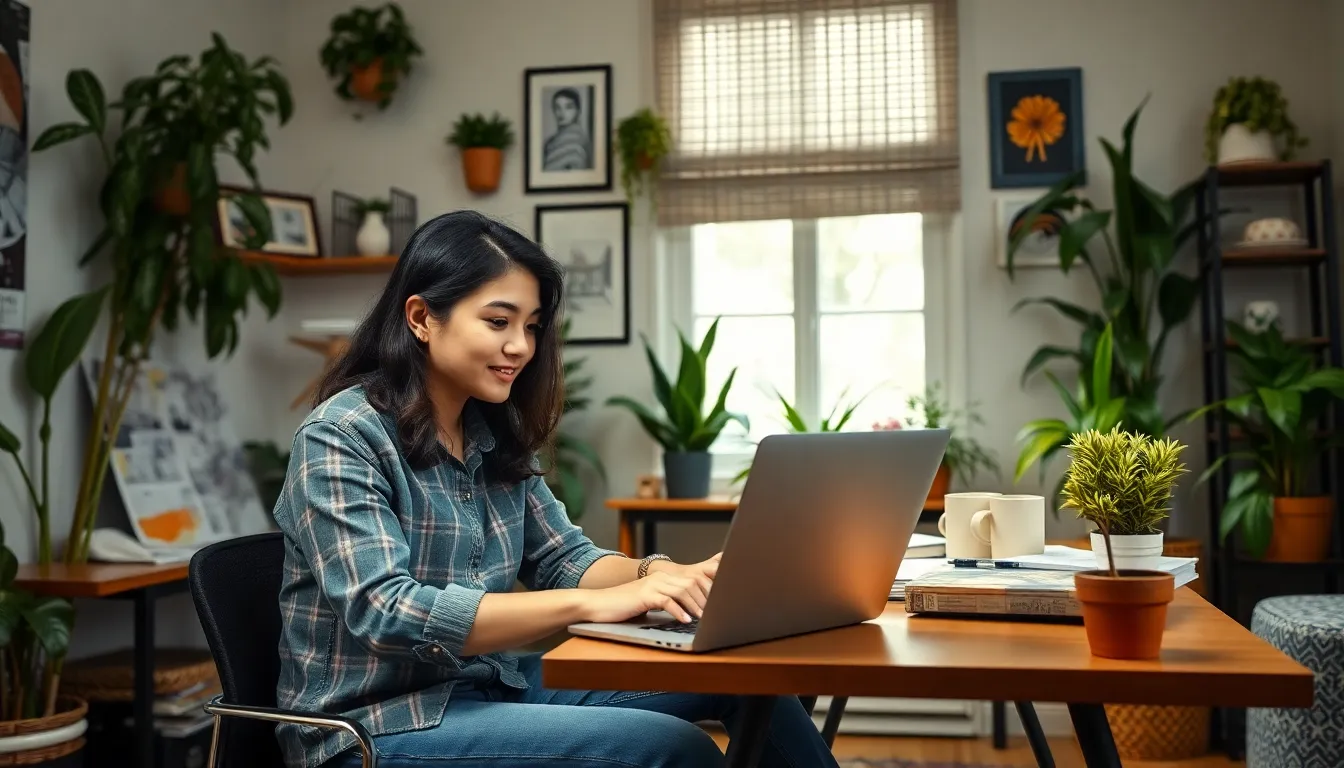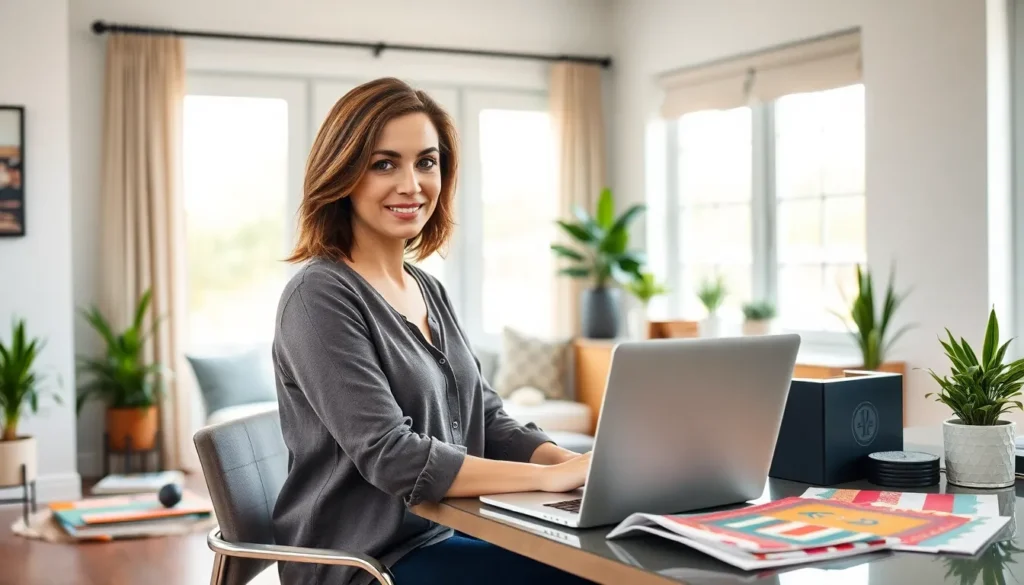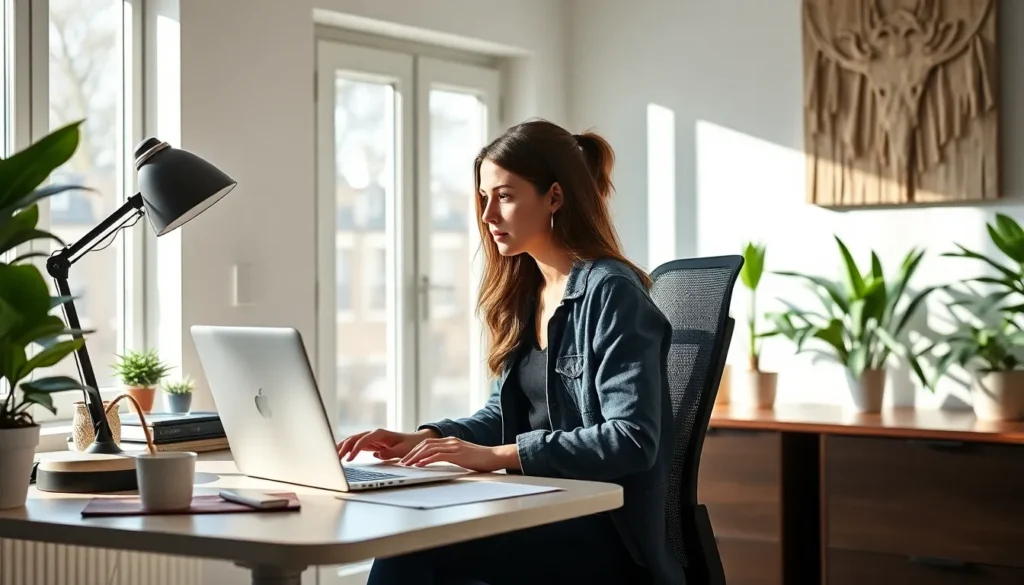In a world where sweatpants are the new power suits, remote interior design jobs are the ultimate blend of creativity and comfort. Imagine transforming spaces from the cozy confines of your couch while sipping on a steaming cup of coffee. It’s like being a magician, but instead of pulling rabbits out of hats, you’re pulling together color palettes and chic furniture arrangements—all without ever having to change out of your pajamas.
As the demand for stylish homes skyrockets, the opportunities for talented designers to work remotely are booming. With clients eager for fresh ideas and innovative designs, the remote interior design field is ripe for the picking. Whether you’re a seasoned pro or just starting out, this career path offers flexibility, creativity, and a chance to make a real impact—all while avoiding the dreaded commute. Who wouldn’t want that?
Table of Contents
ToggleOverview of Remote Interior Design Jobs
Remote interior design jobs combine innovation with flexibility. Designers craft spaces from various locations, leveraging technology to connect with clients and share ideas. Virtual consultations, 3D modeling, and design software enable seamless collaborations, transforming traditional practices.
Companies increasingly seek remote interior designers to adapt to evolving consumer preferences. The rise in home renovations and interior upgrades creates a significant demand for professionals skilled in aesthetics and function. Job listings reveal a variety of positions, ranging from entry-level roles to experienced senior designers.
Creative individuals enjoy the freedom to choose projects that align with their interests and strengths. Designers often specialize in particular styles or types of spaces, such as residential or commercial. This specialization helps them stand out in a competitive job market.
Networking plays a crucial role in securing remote interior design positions. Online platforms and professional communities facilitate connections between designers and potential clients. Building a strong online portfolio boosts visibility and showcases past work.
Professionals in this field report high job satisfaction, mainly due to work-life balance. They appreciate the ability to manage time effectively while pursuing design projects. Remote work arrangements eliminate commuting, allowing for more time dedicated to creativity and client relations.
Current trends indicate a growing interest in sustainable design practices. Many designers prioritize eco-friendly materials and solutions, responding to clients’ increasing environmental awareness. This shift creates additional opportunities for designers committed to sustainable living.
Overall, remote interior design jobs present an exciting blend of creativity, flexibility, and market demand.
Benefits of Remote Interior Design Jobs

Remote interior design jobs offer numerous advantages that attract professionals in the field. Flexibility and work-life balance serve as key benefits, allowing designers to craft their schedules. Working from home means no commute, providing extra time for personal pursuits and creative projects. Designers choose their work environment, which often leads to enhanced productivity. Many report feeling less stressed and more focused when balancing personal life with work responsibilities.
Access to a broader client base stands out as another significant benefit. Designers can connect with clients from various locations without geographical limitations. This diversity opens avenues for unique projects, each providing different design challenges and experiences. Building a strong online portfolio increases visibility and appeal to potential clients. A wider reach can lead to more referrals and repeat business, strengthening professional networks in the interior design industry.
Skills Required for Remote Interior Design
Successful remote interior designers possess a blend of creative and technical skills, along with strong communication and project management abilities. These competencies enhance their effectiveness in a dynamic work environment.
Creative and Technical Skills
Creativity defines the core of interior design. Understanding color theory, spatial arrangement, and style trends allows designers to craft visually appealing spaces. Technical skills play a complementary role. Mastery of design software like AutoCAD, SketchUp, or 3D modeling tools enables professionals to produce detailed renderings of their ideas. Designers often utilize virtual reality or augmented reality for immersive presentations, enhancing client understanding. Keeping up with industry trends ensures they remain competitive in their field. Knowledge of sustainable materials and practices can also cater to a growing demand for eco-friendly designs.
Communication and Project Management Skills
Effective communication is essential in remote interior design. Professionals often interact with clients through virtual meetings and emails, explaining design concepts and gathering feedback efficiently. Clarity in discussing these ideas fosters strong relationships. Project management skills help designers coordinate multiple tasks and deadlines. Juggling several projects at once requires organization and time management. Utilizing project management software like Trello or Asana aids in tracking progress. Flexibility in adapting to client needs and responding to changes showcases their ability to effectively manage relationships and projects simultaneously.
Finding Remote Interior Design Jobs
Remote interior design jobs are increasingly accessible through various channels tailored to meet the unique needs of designers. These platforms streamline the job search and enable designers to connect with clients effectively.
Job Boards and Freelance Platforms
Job boards provide a curated selection of remote interior design positions. Popular sites like Indeed and Glassdoor often feature full-time roles, while freelance platforms such as Upwork and Fiverr cater to project-based work. Designers can create profiles showcasing their expertise and completed projects, attracting potential clients with ease. Many freelance platforms offer tools to facilitate communication and project management, enhancing the designer-client relationship. Listings typically span various experience levels, enabling both novice and seasoned designers to find suitable opportunities.
Networking and Social Media
Networking plays a crucial role in finding remote interior design jobs. Engaging on social media platforms like LinkedIn, Instagram, and Facebook allows designers to share their work and connect with industry professionals. Joining design groups and forums enhances visibility and provides insights into job openings. Regularly interacting with peers and potential clients fosters relationships that can lead to project referrals. Designers can also attend virtual industry events, workshops, and webinars to expand their network and learn about emerging trends and best practices.
Challenges in Remote Interior Design Jobs
Remote interior design jobs come with unique challenges. Working from home can lead to feelings of isolation, affecting creativity and team dynamics.
Isolation and Collaboration Issues
Isolation becomes a common issue as designers work independently. Lack of face-to-face interactions can hinder brainstorming sessions and spontaneous collaboration. Even though technology facilitates virtual meetings, it doesn’t completely replicate the energy of in-person discussions. Team members may miss out on quick feedback or the opportunity to build camaraderie over shared experiences. Overcoming this challenge requires intentional effort to engage through video calls and collaborative platforms. Regular check-ins and team-building activities help maintain connections in a remote setting.
Time Management and Distractions
Time management often proves difficult in home environments. Distractions such as household chores or family members can interrupt focus. Establishing a dedicated workspace minimizes these interruptions, allowing designers to concentrate better on tasks. Balancing multiple projects poses its own set of challenges. Designers may feel overwhelmed, especially when deadlines approach. Utilizing time-blocking techniques or productivity apps can enhance efficiency. Prioritizing tasks according to urgency can greatly improve workflow, helping designers meet client expectations without sacrificing quality.
Remote interior design jobs offer a unique opportunity for professionals to thrive in a flexible and creative environment. As demand for stylish and functional spaces continues to rise, designers can leverage technology to connect with clients and showcase their talents from anywhere.
While challenges like isolation and time management exist, the benefits of improved work-life balance and access to a broader client base make this field increasingly appealing. By honing essential skills and building strong online portfolios, designers can navigate this dynamic landscape successfully. Embracing the possibilities of remote work can lead to fulfilling careers that blend creativity with convenience.





